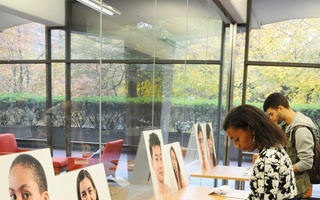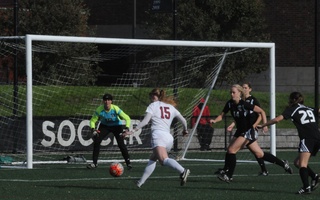On Sunday, Oct. 25, “OTHER: A Multiracial Student Photo Gallery,” an exhibit by Amanda J.N. Mozea '17, opened at the Student Organization Center at Hilles. Meant to expose attitudes toward multiracial students at Harvard, the gallery consists of photographs of more than 50 biracial students and includes their answers to questions regarding their race. With this gallery, Mozea intends to create a space to help others better understand identity.
As a biracial student, Mozea, an inactive Crimson editor, claims that she herself experiences the ignorant behavior she hopes to lay bare with this exhibit. She says that her experience at a black association event, when a girl implied Mozea didn’t have enough phenotypically black features to justify her presence there, inspired her to create the project. “This project was started in a lot of ways out of my hurt...and my desire to show everyone how insensitive and wrong comments like that are,” she says. “But as I began this project…it became more of a cathartic experience.”
Other models express similar sentiments. “I’ve felt fetishized by people for being mixed. That’s an uncomfortable feeling,” Amanda L. Beattie ’17 says.
Mozea stripped the models of all ornament, leaving them bare-faced for the shoots. “There was kind of a methodology behind that,” she says. “And it was so that [for] every model you see, the only thing looking out of their picture is themselves. And the hope is that you will form a connection…. I want you to exchange glances with the people you see.”
Being so naked on camera was the hardest part for some models, like Javier Cuan-Martinez ’18. “[The photos] are very bare,” he says. “There’s no filter, no nothing. That’s who you are in your purest form. That to me was a little shocking.”
In an effort to engage with her audience, Mozea includes a pair of boxes beneath photographs of two ethnically ambiguous male models with the captions, “What is Alexander?” and “What is Jordan?” and a prompt for viewers to answer on a sheet of paper. “It’s very natural for us to label people subconsciously,” she says. “I wanted those boxes to make it overt...and have people acknowledge that when you look at Jordan [or] Alexander, you’re going to label them.”
With these boxes, Mozea intends to show the arbitrary nature of labels. “The exhibit highlights how we can’t be put in a box,” said Rakesh Khurana, dean of the College, at the opening. Drawing from his own experiences with his children, who are biracial, he explained what the exhibit means to him. “Our way to define ourselves is our own right,” he said. “It’s not something that someone can do for you. This exhibit begins to raise those questions in an important and fundamental way.”
In attempting to answer such questions, the exhibit works to establish a community for people to start conversations about race. For instance, reading the transcripts of interviews with other models about how they define themselves has provided Cuan-Martinez with new perspectives. “One of the girls said that she defined herself as a lesbian,” he says. “I never attributed my sexuality to who I am because it’s been so natural to me to be heterosexual…. To see someone else define themselves with something that’s not visible…is really what hit me hard.”
Beattie agrees. “It’s helpful to help people realize the complications of racial identity,” she says. She better appreciates the community she is a part of after meeting and hearing what others had to say. “I got to feel like [I was] part of a community [coming from] a biracial culture,” she says. “It’s kind of a powerful place to be, to be able to dismantle ideas about race just by being myself.”
By initiating this discussion about race, the gallery seeks to enlighten not only visitors but also participants about the multiple layers that constitute multiraciality. According to Mozea, working on the project has also had profound effects on her. “It showed me the shortcomings that I had in my approach to this project,” she says. “I [now] have a much more full and much more human picture of what it means to be confused about race because there were so many approaches that I wasn’t able to consider before.”
Read more in Arts
Boston Calling September 2015: Alabama ShakesRecommended Articles
-
m.i.t.EXHIBIT: "Scientific Instruments in Eighteenth Century Culture"; Margaret Hutchinson Compton Gallery, Rm. 9-150; through Sunday EXHIBIT: "Body Language: Figurative Aspects
-
Newbury Street: Boston's World of Art Tour of the GalleriesThis is the second of two articles by Thomas E. Stebbins Jr. on local art galleries. Mr. Stebbins is a
-
Sidney J. HurwitzYesterday's opening of a new gallery at the Club Mt. Auburn threatens to arouse the most profound disillusionment among the
-
 Photo Gallery Highlights Multiracial Student Experiences
Photo Gallery Highlights Multiracial Student Experiences -
 Harvard Today: October 26, 2015
Harvard Today: October 26, 2015













